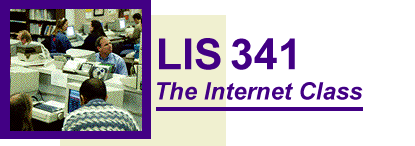
JUMP TO: Overview | Objectives | Expectations | Integrity | Requirements | Grading
Introduction to Internet Resources and Services is a formal and multi-disciplinary introduction to the "community of networks" known as the Internet. The student initially will learn the fundamentals of how the Internet operates and how to use it effectively, and then build upon this foundation to become an active and productive participant in this electronic community.
The Internet is not merely the topic of this class. It will be an integral part of the learning experience. Conventional classroom lectures and assignments will be complemented by activities mediated through the Internet.
We will consider many different aspects of the net, ranging from engineering operations to business opportunities to social and political concerns. We recognize, however, that the library and information science professional has a special responsibility as the intermediary and facilitator to information. Therefore, we shall pay particular attention to the methods for discovery, evaluation, organization and presentation of information on the net.
This course is designed to help the student:
At the conclusion of this course, the student should have acquired the following skills:
Academic IntegrityThe instructor will not tolerate any violations of academic integrity. This includes not only the most egregious violations such as plagiarism, cheating and fraud, but also actions such as double submission, improper paraphrasing, and unauthorized collaboration. It is your responsibility to understand and avoid unacceptable behaviors. The instructor will report violations to Student Judicial Services and institute disciplinary proceedings, as called for in the UT General Information Bulletin, Appendix C, Section 11-802. |
The following texts are required:
Lehnert, Wendy G. Internet 101. Reading, MA: Addison-Wesley, 1998.
Castro, Elizabeth. HTML 4 for the World Wide Web. Berkeley, CA: Peachpit Press, 1998.
The University Co-op has ordered these books as a package (ISBN 0-201-63656-5) which is slightly discounted off the individual book price.
The following text is optional:
Ackerman, Ernest, and Karen Hartman. Searching and Researching on the Internet and the World Wide Web. Wilsonville, OR: Franklin, Beedle & Associates, 1998.
Additional readings will be assigned. Many will be available on-line and linked into the schedule. Others may be available on reserve in the Perry-Castañeda Library or the GSLIS IT Lab.
Basic computer skills are a prerequisite for this course. The student will need to be familiar with one of the following computer systems: Windows, Macintosh, or Unix. The student should have mastered the following skills:
Students should have had some prior exposure to the Internet, including experience browsing the web and using email. These basic skills will not be taught in the classroom. Students without this background still may participate (successfully) in this course, but it is their responsibility to contact the instructor and develop a remedial plan of action. This statement is not meant to discourage such students from enrolling in the class, but rather to make them aware that extra-curricular effort will be required on their behalf.
This class requires convenient Internet access, an Internet email address, use of a WWW server, and client software associated with numerous Internet protocols. The resources in the IT Lab in SZB-451 will meet these requirements. Therefore, all students are strongly urged to obtain an account on the GSLIS cluster -- even if they have an account with an Internet provider or elsewhere in the University. Students who wish to participate in (and receive credit for) the laboratories must obtain a GSLIS account. These accounts can be accessed from home, e.g. through a telesys dialin. Accounts created for this class (i.e. non-GSLIS students) are temporary, and will be purged shortly after the end of the semester.
Students will need access to a text processor and letter-quality printer to prepare essays and reports.
Students will need several blank diskettes. Students probably will need to bring disks when working in the IT Lab, e.g. to store mail folders, news subscription list, file uploads and downloads, etc. Also, students will need to create frequent, periodic backups of their work to avoid catastrophic loss.
Final grades will be assigned on the following scale:
Scale for Final Grades A- 90 - 92% A 93 - 96% A+ 97 - 100% B- 80 - 82% B 83 - 86% B+ 87 - 89% C- 70 - 72% C 73 - 76% C+ 77 - 79% D- 60 - 62% D 63 - 66% D+ 67 - 69% F below 60%
The components of the final grade are:
Component Amount of
Final GradeCollaborative Project 30% Three Quizzes 30% Homework Assignments 15% Instructional Tutorial 10% Two Essays 10% On-Line Participation 5%
Most assignments are assigned a numeric grade. Some, such as the essays, will be assigned a letter grade. For those assignments, you may calculate the numerical value from the following table:
Value of Letter Graded Assignments A- 92% A 95% A+ 100% B- 82% B 85% B+ 88% C- 72% C 75% C+ 78% D- 62% D 65% D+ 68% F 0%
$Id: description.html,v 4.4 1999/02/04 08:49:23 chip Exp $